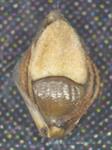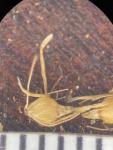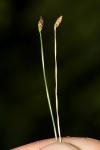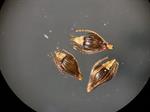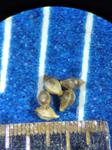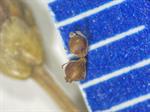Click the number at the start of a key lead to highlight both that lead and its corresponding lead. Click again to show only the two highlighted leads. Click a third time to return to the full key with the selected leads still highlighted.
1 Plants producing only vegetative culms, no reproductive culms present. |
..2 Culms usually firm or hard, 0.35-3 mm wide, compressed; plants tip-rooting in terrestrial wetland habitats. |
....3 Culms 0.35-2 mm wide; bearing up to 8 subacute ribs; distal leaf sheath not bearing an apical tooth [calcareous brackish or tidal habitats, inland calcareous fens, other similar limestone-influenced wetlands; ME, ON, south to FL, TX, further westward] |
....3 Culms 0.5-1.3 mm wide; usually with 10 blunt ribs, finely ridged and minutely granular (at 20x); distal leaf sheath nearly always bearing an apical tooth up to 2 mm long; [freshwater habitats, coastal plain ponds, often acidic; MA w. to MI, south to TX and FL] |
..2 Culms wiry, soft, 0.1-0.7 mm wide, variously shaped but not conspicuously compressed; plants growing submersed or floating in aquatic habitats (e.g. creeks, ponds, rivers). |
......4 Plants with rhizomes (0.5-2 mm thick); with submersed flaccid culms internally spongy bearing incomplete transverse septae (aquatic forms). |
........5 Tubers absent; culms emerging from jointed elongate stolons; [Sinkhole ponds, depression ponds, sawgrass sloughs, lakeshores, creeks, canals, ditches; NC to FL, w. to TX] |
........5 Tubers sometimes present; plants with rhizomes but typically growing more tufted; [Sinkhole ponds, depression ponds, blackwater impoundments, natural lakes, millponds, springs; typically fresh-water habitats; Ont. and Que. south to MS and FL] |
......4 Plants without pronounced rhizomes (sometimes with short caudexlike rhizomes in E. vivipara), submersed or flaccid culms lacking transverse septae. |
..........6 Culms producing secondary or tertiary proliferations (proliferous spikelets branching more than once per culm). |
............ 7 Base of whorl abruptly widened from culm, forming a distinct shoulder; whorl divisions many per whorl (commonly 20 or more); whorl divisions usually 0.2 mm or less wide, finely capillary (often < 0.1 mm, but some may approach 0.3 mm); surface texture of divisions obviously beaded (under dissecting microscope); plants ultimately appearing "fan-like" towards terminal whorls |
............ 7 Base of whorl gradually widened from culm, vase-shaped, not forming a distinct shoulder; whorl divisions fewer per whorl (commonly 15 or less); whorl divisions usually 0.3 mm or more wide (0.5 mm or more, but the finest secondary or tertiary divisions as slender as 0.15 mm); surface texture of divisions not beaded (under dissecting microscope); plants appearing less "fan-like" towards terminal whorls |
..........6 Culms producing a single proliferous spikelet (not proliferating more than once per culm). |
............ ..8 Upper portion of sheath thin and scarious, the edge not differently colored (sometimes with a few red-brown spots or streaks, but not with concentrated red dots at the tips); sheath tip 1-2 mm long; plants usually filiform and capillary; without rhizomes |
............ ..8 Upper portion of sheath firm, the edge closely red-dotted; sheath tip < 1 mm long; plants soft or firm (emergent plants typically more robust); with thin caudex-like rhizomes |
1 Plants with a few reproductive culms present; plants thus a mix of predominantly vegetative culms (bearing proliferous spikelets) and a few spikelet-bearing culms. |
............ ....9 Culms wider, 0.35-2 mm in diameter, typically strong or firm, usually darker green colored with erect and arching culms, not spotted. |
............ ......10 Leaf sheath summit with narrow tooth (up to 1 mm long); achene blackened, apex widened and truncate; [widespread, primarily in Coastal Plain, disjunct in Ridge and Valley province of VA] |
............ ......10 Leaf sheath summit truncate, sometimes with callous swelling; achene green to medium or dark brown, apex rounded, not widened and truncate; [widespread northward within calcareous fens and brackish wetlands, scattered southward in brackish habitats] |
............ ....9 Culms thinner, 0.1-0.4 (-0.6) in diameter, soft and wiry, often arching and light green colored, sometimes spotted or red-brown streaked. |
............ ........11 Culms producing 2 or 3 proliferous whorls; plants usually growing aquatically or submersed under water in ponds, lakes, or depressions. |
............ ..........12 Spikelets with a single flower and 2 scales; achenes biconvex, with a beak, but lacking a tubercle (plants rarely reproductive) |
............ ..........12 Spikelets with 5-25 scales, spiraled; achenes trigonous with prominent angles, with a pronounced tubercle (plants often with some reproductive culms) |
............ ........11 Culms only producing 1 proliferous whorl; plants growing submersed in water or emergent in drawdown zones of ponds and other aquatic or wetland habitats. |
............ ............ 13 Achenes finely to coarsely honeycomb-reticulate or with an otherwise reticulate or porose surface. |
............ ............ ..14 Scales 2-6 per spikelet, arranged distichously; tubercle trilobed and decurrent on achene sides; [waif; Mobile, AL] |
............ ............ ..14 Scales 5-25 per spikelet, spiraled; tubercle trigonous, not decurrent on achene sides [widespread in southeastern Coastal Plain] |
............ ............ 13 Achenes smooth to finely reticulate, but lacking a defined porose or textured surface. |
............ ............ ....15 Achenes often spotted, gray or greenish to red-brown; spikelets distichous or spirodistichous; sheath apex obtuse, acute, or narrowly acute; bristles clearly or sparsely retrorsely spinulose |
............ ............ ......16 Sheath apex obtuse or acute; spikelets distichous at maturity; bristles 3-7 |
............ ............ ......16 Sheath apex narrowly acute, membranous, usually with torn edge; spikelets spirodistichous at maturity (appearing superficially spiraled); bristles 6 |
............ ............ ....15 Achenes not spotted (or rarely spotted), usually white or light grey colored; spikelets spiraled; sheath apex narrowly acute; bristles not evidently spinulose |
............ ............ ........17 Scale apices rounded throughout, typically more uniform white-colored; proximal scale tip appressed to basal scales; tubercle birettaform; bristles to 0.3 mm long (distinctly shorter than achene) or absent |
............ ............ ........17 Scale apices subacute to acute throughout (sometimes a few obscurely rounded), typically with red-tinging on the scale margins; proximal scale free (i.e. not tightly appressed to basal scales); tubercle pyramidal, semicircular, or birettaform; bristles 0.2-1.0 mm long (shorter than or equaling achene, rarely absent) |
............ ............ ..........18 Perianth bristles 0.6-1 mm long, shorter than to equaling achene; proximal scale of spikelets 0.8-1 mm wide |
............ ............ ..........18 Perianth bristles 0.2-0.4 mm long, shorter than achene; proximal scale of spikelets 0.4-0.5 mm wide |
1 Tubercle (0.9-) 1.2-1.7 mm long, noticeably larger than achene |
1 Tubercle distinctly smaller than and not exceeding the achene size; at least the length, width, or both, smaller than achene dimensions (typically < 0.8 mm long). |
..2 Achene apex conspicuously truncate and flattened; mature achenes black |
..2 Achene apex not truncate; instead rounded towards the tubercle, the junction of the achene and tubercle with or without a tapered transition zone ("neck"); mature achenes variously colored (sometimes dark brown or chestnut brown, but never black). |
....3 Tubercle confluent with achene (not clearly differentiated); thus, tubercle base and achene apex merged and with little to no demarcation. |
......4 Achenes (0.75-) 0.9-1.2 mm long, stramineous to golden-yellow or pale brown colored; plants with tubers or terminating rhizomes noticeably J-shaped, 0.5-1 mm wide; [mostly coastal, brackish, or tidal habitats, rarely occurring within inland salt marshes, sect. Parvulae] |
......4 Achenes 1.5-2.5 mm long, stramineous, medium brown, to gray-brown colored (greenish on immature achenes); plants tufted, tip-rooting, or rhizomatous (if rhizomatous, then with terminating bulbs, but not J-shaped tubers); [plants usually of inland fens, seepages, or other similar calcareous, or lime-influenced habitats; also in coastal, brackish marshes]. |
........5 Spikelets with 3-10 scales; achene apex with thin "neck" below confluent tubercle, plants without tip-rooting culms or proliferous spikelets (instead plants erect, with terminal bulbs usually present on creeping rhizomes); culms subterete to slightly compressed; culms up to 2x as wide as thick; [subgenus Zinserlingia] |
........5 Spikelets with 20-40 scales; achene apex without "neck" below confluent tubercle, plants usually with some culms tip-rooting; culms compressed, 1.5-3x as wide as thick; [subgenus Eleocharis, ser. Rostellatae] |
....3 Tubercle not confluent with achene (these structures distinguishable, with a distinct separation between). |
..........6 Achene 1.2-1.7 (2.5) mm long; culms usually spirally twisted, acutely triangular or elliptic; scales spirally arranged; achenes coarsely honeycomb-reticulate |
..........6 Achene 0.45-1.2 mm long; culms not spirally twisted, variously shaped; scales distichous, spiraled, or spirodistichous; achenes smooth to finely or coarsely honeycomb-reticulate. |
............ 7 Some or most culms with the distal leaf sheath apex bearing a distinct tooth, the tooth (usually at least 0.2 mm long) sharpened to an apical point and much thinned from the obtuse or subtruncate (sometimes acute in E. tenuis) sheath below; distal leaf sheaths persistent (not splitting). |
............ ..8 Achene surface smooth to finely reticulate (at 20-30x), not distinctly rugulose or honeycomb-reticulate; achenes 0.6-0.8 mm long; culms 20-55 cm long; [rare, s. TX]. |
............ ....9 Bristles 3-6, rudimentary to < 1/2 the achene length; achenes 0.6-0.65 mm long, compressed-trigonous; culms soft and spongy, without internal septae; spikelets narrowly lanceoloid to cylindric, 1-1.5 mm wide |
............ ....9 Bristles 5-6, their length equaling the achene; achenes 0.6-0.8 mm long, occasionally some appearing biconvex; culms with internal septae (these only evident after sectioning the culm); spikelets lanceoloid, 2-2.5 mm wide |
............ ..8 Achene surface honeycomb-reticulate or finely rugulose; achenes 0.6-1.2 mm long; culms 5-90 cm long; [collectively widespread]. |
............ ......10 Bristles present, 1-5 ( E. fallax) or 5-6 ( E. montevidensis), usually about as long as achene (rarely rudimentary); achenes compressed-trigonous with angles often obscured; [fresh to brackish habitats of the outer Coastal Plain]. |
............ ........11 Culms 40-70 cm tall; scales hyaline with red-brown to blackish brown central stripes; achenes prominently pitted like a honeycomb (prominently rugulose); tubercle 0.3-0.5 mm tall |
............ ........11 Culms usually up to 37 cm tall (reportedly taller, but not verified; mostly < 25 cm tall in NC and SC); scales hyaline with orange-brown to dull orange central stripes (notably orangey on fresh specimens); achenes faintly or obscurely pitted (finely rugulose); tubercle 0.25-0.3 mm tall |
............ ......10 Bristles absent, or if present only 1-3 (these usually falling at maturity); achenes keeled or prominently trigonous; [wet acidic or calcareous sites; throughout coastal plain or inland]. |
............ ..........12 Achenes with 3 prominent raised angles (keels); achene surface rugulose; bristles absent |
............ ..........12 Achenes evidently trigonous, but lacking 3 prominent keels; achene surface finely to coarsely rugulose; bristles absent or present. |
............ ............ 13 Achenes 0.7-1.2 mm long, persistent after scales fall; bristles absent or if present then to 1/2 the achene length; achene faces with 12-20 horizontal ridges (wavy rows) from apex to base of achene; culms usually 6-8 angled; [usually wet calcareous habitats; scattered PA southward, more common northward] |
............ ............ 13 Achenes 0.6-0.9 mm long, not persistent (falling with or before scales); bristles absent or if present, 1-3, up to as long as achene length, and usually falling at maturity; achene faces with 6-12 ridges (or rows of depressed cells) from apex to base of achene; culms usually 4 (-5) angled; [widespread in e. US]. |
............ ............ ..14 Rhizomes (1.1-) 1.4-1.9 (-2.3) mm wide, appearing thick relative to short internode lengths of (0.9-) 1.3-2.6 (-4.4) mm, scales of rhizome (1.4-) 2.3-3.3 (-4.6) mm long; tubercles typically ¾ the width of achene, greatly depressed, rarely pyramidal; achenes 0.6-0.7 (-0.9) mm in length to base of tubercle by 0.5 (-0.7) mm wide, coarsely (to finely) rugose to cancellate (at 10× magnification); [intermittent from e. PA and NJ south to GA, west to e. NE, OK, and TX, where more common] |
............ ............ ..14 Rhizomes 0.6-1.4 (-1.9) mm wide, appearing delicate or slender relative to long internode lengths of (2.6-) 3.5-7.7 (-10.0) mm, scales of rhizome (3.7-) 4.4-8.5 (-10.2) long; tubercles typically less than ¾ the width of achene, pyramidal to depressed; finely rugulose to finely cancellate (at 10× magnification). |
............ ............ ....15 Culms sharply angled, usually deeply sulcate, to 0.8 mm wide; distal leaf sheaths usually with stout apical tooth 0.4-0.6(-0.9) mm; rhizomes slender, (0.8-) 0.9-1.4 (-1.9) mm wide, with longer internodes (3.2-) 4.6-7.7 (-10) mm, scales of rhizome (3.7-) 5.1-8.5 (-10.2) mm in length; tubercles depressed, rarely pyramidal (0.3-) 0.4-0.6 mm wide; achene elongate obovate to faintly spatulate, (0.7-) 0.9-1.1 mm long by 0.6-0.8 mm wide, obscurely to finely rugulose (at 10× magnification); [w. NC northeast to se. ME, disjunct to s. IL] |
............ ............ ....15 Culms bluntly angled to smooth, seldom deeply sulcate, to 0.5 mm wide; distal leaf sheaths with or without apical tooth to 0.2 mm; rhizomes delicate to slender, 0.6-1.0 (-1.2) mm wide, with longer internodes (2.6-) 3.5-5.9 (-8.0), scales of rhizome (3.7-) 4.4-6.7 (-7.9) mm in length; tubercles pyramidal, rarely depressed (0.2-) 0.3-0.4 mm wide; achene obovate, rugulose to finely cancellate at 10×; [e. KY and w. NC northeast to NS] |
............ 7 Distal leaf sheath apex of culms without a distinct, abrupt tooth; instead the sheath apex acute, blunt, or rounded; if sometimes with a subacute, linear blade (as in E. intermedia) then gradually widened at the base and otherwise with a papery or membranous texture; distal leaf sheaths often persistent, but sometimes membraneous and disintegrating. |
............ ............ ......16 Achenes smooth, sometimes finely pitted (as in E. brittonii) or finely reticulate, i.e. with a network of veins or appearing lattice-like (as in E. baldwinii), but never bearing a distinctly wrinkled, honeycomb-reticulate, or otherwise textured surface. |
............ ............ ........17 Proximal (bottom-most) scale of spikelet not amplexicaulous (only spanning 1/2 the width of culm); scales 10-100 per spikelet; culms elliptic, subterete, or terete (occasionally polygonal, but not conspicuously quadrangular or sulcate); plants without proliferous spikelets. |
............ ............ ..........18 Bristles absent; plants cespitose annuals; achene length 0.5-0.6 mm, achene width 0.33-0.4 mm; culms 1-9 cm long, very soft; achenes pearly white to grayish; [primarily FL, rare further north; flatwoods and other moist, terrestrial sites] |
............ ............ ..........18 Bristles present, 5-8 (usually 6); plants perennial with soft rhizomes; achene length 0.8-1 mm, achene width 0.7-0.8 mm; culms 10-40 cm long, soft to firm; achenes dark brown when mature; [MD to FL, w. to TX; brackish or highmarsh sites, usually coastal]. |
............ ............ ............ 19 Spikelets (2.3-) 2.4-3.2 (-3.7) mm wide; plants 15-24 (-28) cm tall, culm ± erect; achenes 0.65-0.8 mm wide; tubercles 0.25-0.3 (-0.35) mm wide; bristles rarely exceeding the tubercle, (0.8-) 1-1.1 (-1.2)× as long as achene-tubercle complex; [widespread from MD to FL, w. to TX] |
............ ............ ............ 19 Spikelets 1.5-2.3 (-2.4) mm wide; plants 30-40 cm tall, culm lax; achenes 0.5-0.6 mm wide; tubercles 0.1-0.2 mm wide; bristles exceeding the tubercle, 1.2-1.7 (-2)× as long as achene-tubercle complex; [Camden Co., GA; perhaps to be found to be somewhat more widespread] |
............ ............ ........17 Proximal (bottom-most) scale amplexicaulous (or nearly so); scales 2-28 per spikelet (13-76 in E. brittonii); culms typically quadrangular or sulcate (grooved), sometimes broadly elliptic; plants with or without proliferous spikelets. |
............ ............ ............ ..20 Plants never with proliferous spikelets, rhizomes present (but plants still appearing cespitose or tufted); achenes white or brown, not spotted. |
............ ............ ............ ....21 Bristles absent, or if present, 1-4, rudimentary to shorter than achene length, colorless to white; achenes typically biconvex, but rarely trigonous; [GA and FL w. to MS] |
............ ............ ............ ....21 Bristles 6, equaling to far exceeding tubercle, red-brown; achenes trigonous with prominent angles; [FL] |
............ ............ ............ ..20 Plants often with a few to many proliferous spikelets, without rhizomes; achenes white, brown, grey, green, olive, or reddish-brown, spotted or not. |
............ ............ ............ ......22 Scales 2-ranked, obviously distichous; scales fewer, typically 2-4 (-9); bristles 6 |
............ ............ ............ ......22 Scales spirally imbricate or spirodistichous (i.e. appearing superficially spiraled as in E. minima); scales >10 per spikelet (occasionally as few as 4 in E. minima); bristles present or absent. |
............ ............ ............ ........23 Spikelets with proximal scale deciduous or sometimes persistent on some spikelets, proximal scale appearing similar to other scales (when still present); achenes greenish to pale or reddish brown, usually broadest near the middle; perianth bristles present, slightly shorter than achene to exceeding tubercle; culms (1-) 3-7 (-13) cm long, usually flexuous and recurved; tubercle 0.15-3 mm long, broad, covering most of achene summit; [GA and FL w. to TX] |
............ ............ ............ ........23 Spikelets with proximal scale persistent, clearly different from floral scales, usually longer and often resembling involucral bract, often with an excurrent midrib; achenes white or pale gray, broadest above the middle; perianth bristles present or absent, rudimentary to equaling achene; culms 2-40 cm long, ascending or arching; tubercle 0.05-0.2 mm long, shortly pyramidal or birettaform, perched at achene summit and not covering most of it; [collectively widespread]. |
............ ............ ............ ..........24 Proximal scale with rounded apex, the scale elliptic or lanceolate, the tip appressed; scale apices rounded throughout spikelet; perianth bristles shorter than achene or absent; tubercle birettaform (with 3-4 small peaks; resembling a biretta); culms 7-37 cm long |
............ ............ ............ ..........24 Proximal scale with subacute to acute apex, the scale ovate or lanceolate, the tip free; scale apices attenuate to acute throughout spikelet; perianth bristles vestigial to equaling achene or sometimes absent; tubercles pyramidal, semicircular, or birettaform; culms 2-40 cm long. |
............ ............ ............ ............ 25 Perianth bristles 0.6-1.0 mm long (shorter than to equaling the achene); proximal scale of the spikelets 0.8-1.0 mm wide |
............ ............ ............ ............ 25 Perianth bristles 0.2-0.4 mm long (shorter than the achene); proximal scale of the spikelets 0.4-0.5 mm wide |
............ ............ ......16 Achenes finely rugulose (with a wrinkled texture) or honeycomb-reticulate, bearing some texture. |
............ ............ ............ ............ ..26 Culms distinctly compressed (sometimes subterete-compressed in E. compressa var. acutisquamata); at least some scales bifid or shallowly cut; [habitat often calcareous or limestone-derived]. |
............ ............ ............ ............ ....27 Plants densely cespitose (rhizomes present, but concealed by persistent living or dead culm bases); spikelet scales primarily bifid throughout. |
............ ............ ............ ............ ......28 Culm width 0.7-2.3 mm; proximal-most scale of spikelet clasping 2/3-3/4 of culm; flowering and fruiting mostly May-June; [KY and w. VA south through TN to nw. GA and n. AL] |
............ ............ ............ ............ ......28 Culm width 0.2-0.5 (-0.7) mm; proximal-most scale of spikelet amplexicaulous; flowering and fruiting mostly March-May (-July); [endemic to OK and TX] |
............ ............ ............ ............ ....27 Plants perennial, mat-forming (rhizomes not hidden by culm bases); spikelets a mix of entire and bifid scales (the proximal-most scale entire, remaining proximal 1/2 of scales bifid or shallowly cut, and distal scales often entire). |
............ ............ ............ ............ ........29 Culms subterete to slightly compressed, not more than 2 times as wide as thick, (0.2-) 0.5-1 mm wide; [IN, MO, OK, TX, westward] |
............ ............ ............ ............ ........29 Culms bi-laterally compressed, 2-5 times as wide as thick, 0.5-1.8 mm wide; [widespread east of Mississippi River, also north of LA and OK] |
............ ............ ............ ............ ..26 Culms not compressed; instead terete, subterete, elliptic, sulcate (grooved) or with 4-many ridges; if culms ridged, the ridges sometimes sharp and often most evident when culms have dried; apex of scales entire, not bifid (except for E. occulta); [habitat calcareous or acidic]. |
............ ............ ............ ............ ..........30 Spikelets with 2-6 scales; achene apex broad and flattened; tubercle base trilobed, the lobes decurrent along achene angles; [rare, possible ballast waif near Mobile, AL and potentially other Gulf coastal sites] |
............ ............ ............ ............ ..........30 Spikelets with 5-60 scales; achene apex not flattened, instead constricted gradually or abruptly towards apex at junction with tubercle; tubercle not trilobed; [widespread] |
............ ............ ............ ............ ............ 31 Culms bluntly, smoothly, or deeply sulcate, usually 4 (-5) angled with evident ridges or angles; achenes coarsely honeycomb reticulate |
............ ............ ............ ............ ............ 31 Culms not sharply angled; instead terete, subterete, broadly elliptic, or subterete-compressed; achenes papillose, or finely to coarsely honeycomb reticulate. |
............ ............ ............ ............ ............ ..32 Scales of spikelet bifid, 20-50 scales per spikelet; plants densely cespitose and with horizontal rhizomes present (although these obscured by persistent leaf bases); [endemic to OK and TX] |
............ ............ ............ ............ ............ ..32 Scales of spikelet acute or obtuse, not bifid; 5-35 scales per spikelet; plants cespitose or with proliferous spikelets, but lacking horizontal rhizomes; [collectively widespread] |
............ ............ ............ ............ ............ ....33 Achenes 0.6-0.8 mm long, gray or greenish colored, trigonous with prominent angles; plants often bearing some proliferous spikelets; tubercle > 1/3 the length of the achene; [VA s. to FL, w. to TX] |
............ ............ ............ ............ ............ ....33 Achenes 0.9-1.1 mm long, golden yellow to golden brown colored, compressed-trigonous to nearly terete; plants without proliferous spikelets; tubercles typically 1/3 or less than the length of the achene; [TN and NC northward]. |
............ ............ ............ ............ ............ ......34 Plants rhizomatous perennials; achene compressed-trigonous, obovoid to obpyriform; tubercle pyramidal, the width equaling the length; [of coastal fresh to brackish ponds, lakeshores, marshes, and similar habitats; NS s. to NJ, disjunct in e. NC] |
............ ............ ............ ............ ............ ......34 Plants annual, cespitose (with inconspicuous rhizomes); achene nearly terete, narrowly obpyriform; tubercle slender-conic with narrow base; [of basic soils inland, common northeast, scattered southward in WV, VA, and TN] . |
